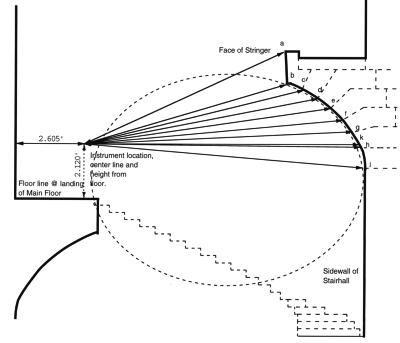
| Practical And Theoretical Applications Of Geometry At Claude Perrault's Observatoire De Paris (1667-1672) |
|---|
History and Theory of Technology and Design
College of Architecture, UNC Charlotte
Charlotte NC. 28223-0001 USA
The Observatoire de Paris (1667-1672) by Claude Perrault, was originally intended to house the Paris Academy of Sciences established by Jean Baptiste Colbert for Louis XIV. The project is little known in architectural histories despite its importance as Perrault's only completed building design and as the first facility in the institutionalization of science. The work presents an understanding of physical geometry that rivals the application of geometry in astronomy during that era, suggesting a range of outside influences upon Perrault. On-site research in Paris involving both field and archival efforts took place during the summers of 1997 and 1999. These examinations involved an instrumented confirmation of the building dimensions, vaulting geometry and structure, masonry construction, unique services and ornamentation, for concordance with existing original drawings.

Vault dimensions, rear stairwell, main floor, Observatoire de Paris (Randy Swanson, 1999)
A brief overview of the facility and the conceptual sources that influenced Perrault will be provided that will lead directly into the following two areas of development revealed by the on-site examination:
- A stereometric achievement - a cantilevered elliptical vaulted semi-helical stairwell form that suggests an advanced level of craft knowledge that is related to but challenges the theoretical efforts of Girard Desargues, (1591-1661) , or Abraham Bosse, in descriptive geometry until the era of Gaspard Monge (1746-1818).
- Subtle dimensional eccentricities that do not easily permit the work to be geometrically understood with the use of regular forms, nor allow the building to be easily resolved as a cube as Professor Perez-Gomez and others have previously suggested.
This paper will present evidence for a practical resolution of the complex stairwell form and compare it to the work of Desargues/Bosse. The paper will suggest that Perrault took the opportunity in the design of the Observatoire as a practical test of his own theories concerning architectural proportions as the justification for the geometrical eccentricities. The paper will close with a suggestion of the impact the Observatoire project in the formation of Perrault's views as presented in his Ordonnance for the Five Kinds of columns after the Method of the Ancients.
ABOUT THE AUTHOR
Randy Swanson is a registered architect, an Associate Professor
in the College of Architecture, and a member of the Graduate
College at The University of North Carolina at Charlotte. He
has a teaching responsibility in the area of the history and
theory of technology and design. Prior to his academic career
he was in practice. In Chicago, Illinois he worked in the firm
of Keck and Keck, Architects, solar residential design pioneers.
He also practiced in the Washington, D.C., area as the project
architect for the rehabilitation and design of several scientific/military
laboratories and medical facilities. His principal areas of research
interest involve the history, evolution and design of technically
complex facilities such as scientific laboratories and medical
facilities. He is currently preparing a manuscript entitled The
Place of Inquiry, which will present a history of the development
of scientific space from 1660 to 1890. His current professional
involvement includes the Society of Architectural Historians,
Society for the History of Technology, Society of Industrial
Archeology, and Society of Building Science Educators.
|
Randy S. Swanson, "Geometry in Perrault's Observatoire", pp. 237-251 in Nexus IV: Architecture and Mathematics, eds. Kim Williams and Jose Francisco Rodrigues, Fucecchio (Florence): Kim Williams Books, 2002. http://www.nexusjournal.com/conferences/N2002-Swanson.html |
|
|
|
|
